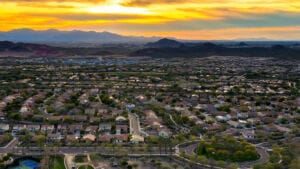
With an average of 299 sunny days per year, it’s no wonder Arizona is experiencing one of the largest increases in solar installations in the nation. The abundance of sunshine is wonderful for creating clean, renewable solar energy, but Arizona’s weather isn’t always ideal for our roofs. Weather factors can greatly affect your solar panel installation.
What you need to know
If considering having solar panels installed on your roof, you should first call a roofer to make an assessment of your existing roof system. Installing a solar system without having your roof checked first can be a costly mistake. If there is an issue with your roof, it will be better to address it before installing your solar system, rather than having to remove the system to correct the problem.
Additionally, make sure your roof’s warranty is still valid with the installation of solar panels. This will eliminate many headaches in the future, should your roof need repairs typically covered under warranty. A roof warranty typically will not cover changes made to the roof system after the fact.
What happens when you don’t get your roof checked?
If you decide to have a solar system installed without having your roof checked by a professional, you might get lucky and not have issues for a few years. However, you could also end up with severe damage to your roof, and as a result, would need to have someone uninstall your solar system, get the needed roof work completed, and then have the solar panels reinstalled.
We would like to believe most solar companies and their representatives are straightforward and ethical. However, it is not always the case. A couple of years ago, one of SUNVEK Roofing’s clients was persuaded by a fast-talking solar representative to have a solar system installed on their south-facing tile roof slopes. Just two years prior, SUNVEK had replaced tile underlayment on the north side of the home, informing the homeowners that the south slopes would need to be addressed within a couple of years.
Shortly after the system was installed, there was a week of rain, and that’s when the problems started. There were a number of leaks, which damaged sheetrock, paint finishes, stained carpets and furniture, and damaged the stain on the wood mantel of the indoor fireplace.
Ultimately, the tile underlayment had to be replaced. To do so, the homeowners had to have the solar company remove, then reinstall the solar panels. This whole process, unfortunately, disrupted their life for about two months, along with the frustration and expense of the interior repairs.
This is just one example of what can happen if your roof isn’t in good condition at time of solar panel installation. Keep in mind, there are ethical solar companies out there that are honest and will mention if your roof looks damaged before installing solar panels. Unfortunately, you still need to be aware that some solar companies will move forward with the installation in spite of there being issues with your roof.
Eric Skoog is president of SUNVEK




